No movement in credit card rates in April

April 30, 2014
Current averages:
- Average consumer credit card rate, overall market: 16.99 percent
- Average consumer non-rewards credit card rate: 15.48 percent
- Average consumer rewards credit card rate: 17.64 percent
- Average student credit card rate: 17.56 percent
- Average business non-rewards credit card rate: 14.99 percent
- Average business rewards credit card rate: 15.41 percent
The U.S. bank prime rate was unchanged in the second half of April, at 3.25 percent.
For the second consecutive semi-monthly survey, none of the credit card offers tracked by IndexCreditCards.com changed rates. It has been a quiet period generally for interest rates. According to figures from the Federal Reserve, as of the last week of April 10-year Treasury bond yields were within four basis points of where were in March, and 30-year mortgage rates were only a single basis point different from where they were last month.
While this has been a peaceful period for interest rates, it would be best to think of it as a fragile peace. There are a number of factors which could change at any time and have an impact on interest rates, including credit card rates. The following are some of those factors:
- Inflation. Inflation has been unusually docile lately, with the Consumer Price Index rising by just 1.5 percent over the past year. Since lenders generally demand interest rates that are higher than the rate of inflation, low inflation has been an important factor in allowing interest rates to be relatively low in recent years. However, the tensions heating up between Russia and Ukraine, not to mention the ever-present potential for trouble in the Middle East, carry the threat of causing energy commodities to spike at any time, which would be likely to also send interest rates upward.
- Accelerated economic growth. In the weeks ahead it will become more apparent what kind of first quarter the economy had, and also the extent to which improving weather is reviving consumer activity. If growth speeds up, interest rates could be headed higher.
- Rising credit concerns. On the other hand, if the economy slows rather than accelerates, this could lead to higher credit card rates due to concerns about creditworthiness. Consumer non-mortgage debt reached an all-time high in January, and a slowing economy could lead to a new debt crisis.
Meanwhile, stability has its benefits for credit card customers, whether they be independent consumers, students or businesses. The availability of consistent information on credit card rates makes it easier to make comparisons and choose the best rates.
Taking the time to make those comparisons can be a money-saving exercise, because while rates on average have been stable, that should not be mistaken as indicating there are no differences between individual credit card offers. Specific rates vary significantly within each of the consumer, student, and business credit card categories, so while rates overall may not have moved, there may still be opportunities for customers to lower their rates.
Consumer credit card rates
Average rates on both consumer non-rewards and rewards credit cards were unchanged in the second half of April, leaving the spread in average rates between the two categories unchanged at 2.16 percent.
Student credit card rates
The average rate among the student credit card offers tracked by this survey has been unchanged since February, at 17.56 percent.
Business credit card rates
Business rewards and non-rewards credit cards were also unchanged in late April. As with consumer credit cards, this left the spread between rates for the two categories unchanged, though at 0.42 percent, this spread is much narrower for business credit cards than for consumer credit cards.
Excellent credit vs. average credit
With no change in any of the credit card offers tracked by this survey, the difference between the average consumer rate and the rate for consumers with excellent credit remained at 3.93 percent.
In total, IndexCreditCards.com surveys information from nearly 50 different credit cards, and includes multiple credit-rating tiers from many of those cards. Examples of offers surveyed include American Express, Capital One, Chase, Citi, Discover, and other MasterCard and Visa branded cards. The information compiled not only demonstrates trends in credit card rates over time, but also indicates the different values credit card companies put on different target markets (consumer, business, etc.), as evidenced by the differences between rates for those markets.
Disclaimer:The information in this article is believed to be accurate as of the date it was written. Please keep in mind that credit card offers change frequently. Therefore, we cannot guarantee the accuracy of the information in this article. Reasonable efforts are made to maintain accurate information. See the online credit card application for full terms and conditions on offers and rewards. Please verify all terms and conditions of any credit card prior to applying.
This content is not provided by any company mentioned in this article. Any opinions, analyses, reviews or recommendations expressed here are those of the author’s alone, and have not been reviewed, approved or otherwise endorsed by any such company. CardRatings.com does not review every company or every offer available on the market.
Published